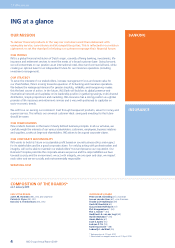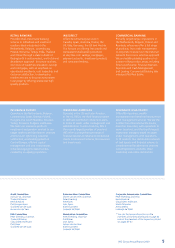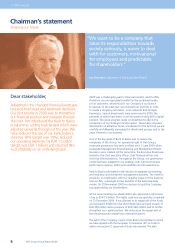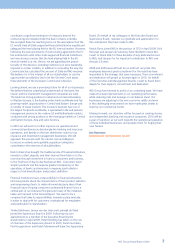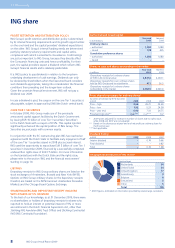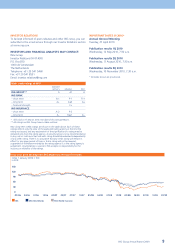ING Direct 2009 Annual Report Download - page 16
Download and view the complete annual report
Please find page 16 of the 2009 ING Direct annual report below. You can navigate through the pages in the report by either clicking on the pages listed below, or by using the keyword search tool below to find specific information within the annual report.
ING and the financial environment (continued)
EUR –1,759 million after tax and included the aforementioned
one-time charge due to an accrual for additional future payments
to the Dutch state of EUR 930 million and a EUR 554 million
restructuring provision, which was predominantly related to
headcount reductions for ING’s Back to Basics programme.
Furthermore, special items included a restructuring charge of
EUR 165 million, as a result of the merger of ING’s retail banking
activities in the Netherlands and a loss of EUR 110 million due to
the IABF with the Dutch State in the first quarter 2009. The positive
net impact of divestments was EUR 77 million in 2009 compared
with a loss of EUR 98 million in 2008.
The full-year 2009 pre-tax adverse market impact was EUR 4,742
million. Impairments and fair value changes on debt securities
had an impact on the result of EUR –1,963 million, compared with
EUR –3,399 million in 2008. Impairments on Alt-A RMBS were
substantially lower at EUR 1,405 million in 2009, down from a
peak of EUR 2,063 million in 2008. Impairments on other debt
securities, including financial institutions’ debt, decreased from
EUR 809 million in 2008 to EUR 174 million in 2009. The equity
securities related impact was EUR –957 million, an improvement
of EUR 404 million compared with full-year 2008. The negative
impact from real estate and private equity increased to EUR 2,100
million compared with EUR 1,587 million in 2008. Real estate
revaluations and impairments remain substantial at EUR –2,156
million in 2009 versus EUR –1,173 million in 2008, despite a
reduction of ING’s direct real estate exposure in 2009.
Private equity revaluations were EUR 56 million, compared with
EUR –413 million in 2008. Other market impact was positive
despite a contribution to the deposit guarantee scheme in the
Netherlands following the bankruptcy of DSB Bank in the
fourth quarter of 2009.
In addition to the market impact, the 2009 result reflected a
EUR 343 million pre-tax charge related to changes in variable
annuity assumptions in the Insurance operations. Additions to
loan loss provisions for the Banking activities were up
EUR 1,693 million to EUR 2,973 million, reflecting the distressed
economy. Basic earnings per share decreased to EUR –0.57 from
EUR –0.27 in 2008. Capital and leverage ratios remained sound.
Shareholders’ equity almost doubled from EUR 17,334 million to
EUR 33,863 million, driven by the net proceeds of the rights issue
and the improvement of the revaluation reserve for debt securities.
The debt/equity ratio of ING Group was 12.4%. The debt/equity
ratio of Insurance ended the year at 9.7% while the Tier 1 ratio
of ING Bank stood at 10.2%. ING Bank’s solvency ratio (BIS ratio)
ended at 13.5%.
Total client balances increased by EUR 62 billion in 2009 to
EUR 1,517 billion at year-end 2009. The net production of
client balances, excluding the impact from divestments, market
performance and currency effects, was EUR 12.1 billion.
CONCLUSION
2009 was an unprecedented year for ING. The financial crisis
and the second use of State facilities in the form of the IABF
necessitated decisive action to stabilise the Company, restore
credibility and regain trust. This prompted us to introduce the
Back to Basics programme. In the first phase of its implementation,
we successfully strengthened the Company’s financial position
by a number of actions to contain costs, reduce risk and capital
exposures, and deleverage the balance sheet.
Also, we simplified the governance structure and made a number
of divestments as a result of a preliminary portfolio review.
Meanwhile, we worked closely with the Dutch authorities and
obtained the EC’s approval for the support received from the
Dutch State. This process acted as a catalyst for the next step
in the Back to Basics programme, i.e. the full separation of the
banking and insurance operations.
On approval of ING’s restructuring proposals, which were
submitted to the EC on the condition that the EC guarantees
equal treatment of all state-supported financial institutions and
safeguards the level playing field in the EU internal market, the
EC also gave final clearance for the capital injection and IABF
received from the Dutch State, albeit that ING also had to make
additional payments for the latter. By the end of 2009 we
announced that we had successfully raised the EUR 7.5 billion
of capital needed to facilitate early repayment of the Dutch State.
Thus, we have set a clear course for the future and been able to
leave a difficult period behind us, closing 2009 on a positive note.
1.2 Report of the Executive Board
ING Group Annual Report 2009
14


